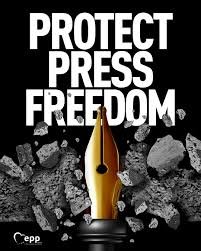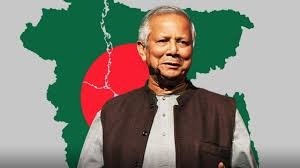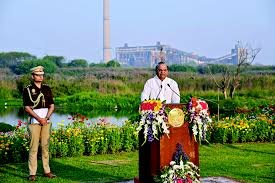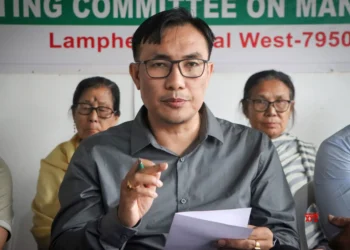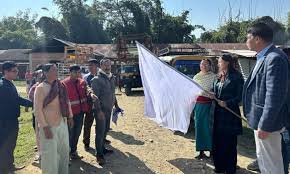The All Manipur Working Journalists’ Union and Editors’ Guild call the blackout a “defensive measure” to protect lives amid mounting intimidation.
BY PC Bureau
October 20, 2025 – In a stark illustration of the perils facing journalism in India’s volatile borderlands, Manipur’s print and electronic media remain silenced for the third consecutive day. Newspapers have vanished from newsstands in the capital, Imphal, and local cable networks have halted news broadcasts for two days.
This blackout stems from a coordinated pen-down strike by the All Manipur Working Journalists’ Union (AMWJU) and the Editors’ Guild of Manipur (EGM). The escalating crisis, triggered by conflicting threats from insurgent groups, underscores the fragile autonomy of the press in a state gripped by ethnic tensions, ongoing violence, and over 35 active militant outfits.
As of Monday, no resolution is in sight. An AMWJU spokesperson confirmed that the strike will continue, urging the public to turn to national media or social platforms for updates. The two bodies have appealed directly to insurgent factions for uninterrupted media operations, but sources report no formal responses yet.
This marks the latest flashpoint in Manipur’s protracted conflict landscape. Media houses here navigate not only editorial ethics but also existential threats, caught in a minefield where objectivity can invite retaliation.
The Spark: A Statement Caught in Crossfire
The blackout began with a quintessential Manipur dilemma — a single insurgent communiqué that pitted one faction against others. Reports indicate that an underground outfit — identity withheld pending confirmation — demanded publication of a press release outlining political demands or cease-fire overtures.
Competing groups, fearing the statement could bolster their rivals, issued counter-threats of “dire consequences” to dailies and cable channels should it appear in print. This tug-of-war is not abstract; it is enforced by the threat of violence.
In a state scarred by ethnic clashes since May 2023 — pitting the majority Meiteis against minority Kukis and Nagas, resulting in over 250 deaths and 60,000 displacements — insurgents wield considerable influence. With more than 35 outfits operating, from the United National Liberation Front (UNLF) to splinter Kuki and Naga groups, the media has become a battleground for narrative control.
The AMWJU and EGM, after emergency meetings over the weekend, described the strike as a “defensive measure” to safeguard lives and institutional integrity. Their joint statement decried the “untenable pressures” on the fraternity, echoing past pleas for non-interference.
READ: Daylight Heist at Louvre: Eight Imperial Jewels Stolen
READ:Delhi’s Air Turns Toxic Pre-Diwali; AQI Soars to “Very Poor” Levels
Broader Context: A State in Perpetual Flux
Manipur’s media woes are no anomaly; they reflect a deeper malaise. Since the 2023 ethnic violence, the state has faced recurrent blackouts — from internet suspensions to targeted attacks on reporters. In June 2025, curfews and digital curbs followed the arrests of Arambai Tenggol leaders, a Meitei militia accused of fueling unrest.
Insurgent influence is multifaceted. Groups like the UNLF and People’s Liberation Army (PLA) have historically dictated coverage, demanding “equal space” for statements or vetoing stories deemed “anti-revolutionary.”
The state’s porous border with Myanmar — a hub for arms and narcotics — amplifies the problem, with militants funding operations through extortion rackets targeting media houses. A 2024 report by the Committee to Protect Journalists (CPJ) named Manipur India’s “most dangerous” posting for reporters, logging 12 assaults that year alone.
Key Insurgent–Media Incidents in Manipur (2023–2025)
| Description | Impact |
| May 2023 Violence Onset | Militants threaten outlets for “biased” Kuki–Meitei coverage. Temporary print suspensions; 3 journalists injured. |
| July 2024 Press Club Bombing | UNLF splinter group claims responsibility over “suppressed” statement. 2 deaths; heightened self-censorship. |
| June 2025 Curfew Clashes | Arambai Tenggol demands airtime post-arrests. Internet blackout; cable disruptions in Imphal Valley. |
| October 2025 Current Strike | Cross-faction threats over a single communiqué. 3-day newspaper blackout; ongoing cable halt. |
This table reveals a pattern: isolated demands snowball into systemic shutdowns, eroding public trust and amplifying misinformation on platforms like WhatsApp and Facebook, which are rife with ethnic vitriol. In addition, there are several cases of abduction and assault on journalists.
Implications: Eroding Pillars of Democracy
The fallout extends beyond ink and airwaves. For Manipur’s 3.2 million residents, the blackout deepens isolation in a state where local news is a lifeline amid federal neglect.
Rural areas, already underserved, face heightened vulnerabilities. Without dailies newspapers, unverified rumors fuel mob violence — as seen in the 2023 pogroms.
Economically, small media houses — reliant on ad revenue and subscriptions — teeter on collapse, with owners reporting 40–60% losses per strike day. The financial strain threatens their survival.
On a national scale, this episode spotlights Northeast India’s fragile press freedoms. India’s 2025 World Press Freedom Index ranking slipped to 159th, with Manipur cited for
Calls for Intervention
As the strike enters its fourth day, pressure mounts for dialogue. The AMWJU has urged Governor Ajay Kumar Bhalla — who reviewed security last week — to mediate with insurgents via peace interlocutors.
National bodies like the Press Council of India have voiced solidarity, but concrete aid remains limited.
In Manipur, where history is etched in resistance — from the 1939 Anglo-Kuki War to today’s ethnic standoffs — this blackout is more than a labor action. It’s a referendum on whether the fourth estate can endure amid gunfire.
Without swift de-escalation, the silence risks becoming permanent, leaving a state adrift in the shadows of its own making.


